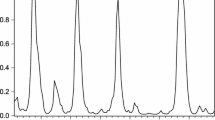Abstract
A desirable property for an estimator of the fractional ARFIMA parameter is to be first difference invariant. This paper investigates the effects on the fractional parameter estimator in nonstationary ARFIMA(p,d,q) processes before and after applying a first difference. We consider semiparametric and parametric approaches for estimating d. The study is based on a Monte Carlo simulation for different sample sizes. The Brazilian exchange rate series is given as an application of the methodology.




Similar content being viewed by others
References
Beran J (1994) Statistics for long-memory processes. Chapman & Hall, New York
Chen SK (1987) Modeling gold price movements and forecasts. Managerial Finance 13 (2):25–28
Cheung Y-W, Diebold FX (1994) On maximum likelihood estimation of the differencing parameter of fractionally-integrated noise with unknown mean. J Econom 62:301–316
Fox R, Taqqu MS (1986) Large-sample properties of parameter estimates for strongly dependent stationary Gaussian time series. Ann Stat 14:517–532
Geweke J, Porter-Hudak S (1983) The estimation and application of long memory time series model. J Time Ser Anal 4(4):221–238
Granger CWJ, Joyeux R (1980) An introduction to long memory time series models and fractional differencing. J Time Ser Anal 1(1):15–29
Hauser MA (1999) Maximum likelihood estimators for ARMA and ARFIMA models: a Monte Carlo study. J Stat Plann Inference 80:229–255
Hosking J (1981) Fractional Differencing. Biometrika 68(1):165–167
Hosking J (1984) Modelling persistence in hydrological time series using fractional differencing. Water Resour Res 20(12):1898–1908
Hurvich CM, Ray BK (1995) Estimation of the memory parameter for nonstationary or noninvertible fractionally integrated processes. J Time Ser Anal 16(1):017–042
Lobato IN, Velasco C (2000) Long memory in stock-market trading volume. J Bus Econom Stat 18(4):410–427
Lopes SRC, Olbermann BP, Reisen VA (2004) A comparison of estimation methods in non-stationary ARFIMA processes. J Stat Comput Simul 74(5):339–347
Lopes SRC, Olbermann BP, Reisen VA (2002) Non-stationary Gaussian ARFIMA processes: estimation and application. Braz Rev Econom 22(1):103–126
Lopes SRC, Pinheiro AS (2006) Wavelets for estimating the fractional parameter in non-stationary ARFIMA process (in press)
Reisen VA (1994) Estimation of the fractional difference parameter in the ARIMA(p,d,q) model using the smoothed periodogram. J Time Ser Anal 15(3):335–350
Reisen VA, Abraham B, Lopes SRC (2001a) Estimation of parameters in ARFIMA processes: a simulation study. Commun Stat Simul Comput 30(4):787–803
Reisen VA, Sena Jr MR, Lopes SRC (2001b) Error and model misspecification in ARFIMA processes. Braz Rev Econom 21(1):101–135
Robinson PM (1995) Log-periodogram regression of time series with long range dependence. Ann Stat 23(3):1630–1661
Sowell F (1992a) Modeling long-run behavior with the fractional ARIMA model. J Monet Econ 29:277–302
Sowell F (1992b) Maximum likelihood estimation of stationary univariate fractionally integrated time series models. J Econom 53:165–188
Velasco C (1999a) Gaussian semiparametric estimation of non-stationary time series. J Time Ser Anal 20(1):87–127
Velasco C (1999b) Non-stationary log-periodogram regression. J Econom 91:325–371
Acknowledgments
V.A. Reisen was partially supported by CNPq-Brazil. S.R.C. Lopes was partially supported by CNPq-Brazil and by Pronex Probabilidade e Processos Estocásticos (Convênio MCT/CNPq/FAPERJ — Edital 2003). S.R.C. Lopes and B.P. Olbermann were partially supported by Fundação de Amparo à Pesquisa no Estado do Rio Grande do Sul (FAPERGS Foundation). The authors would like to thank the editor and the anonymous referee for their valuable comments and suggestions that improved this version of the manuscript.
Author information
Authors and Affiliations
Corresponding author
Rights and permissions
About this article
Cite this article
Olbermann, B.P., Lopes, S.R.C. & Reisen, V.A. Invariance of the first difference in ARFIMA models. Computational Statistics 21, 445–461 (2006). https://doi.org/10.1007/s00180-006-0005-0
Published:
Issue Date:
DOI: https://doi.org/10.1007/s00180-006-0005-0




